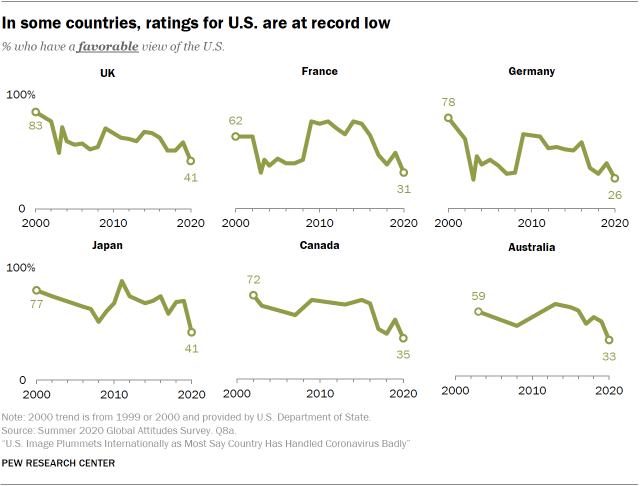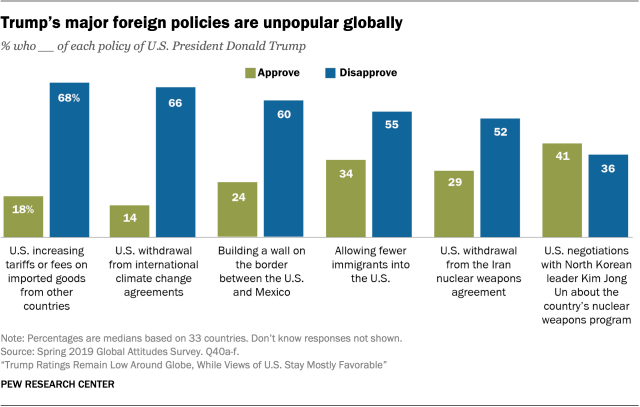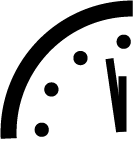Go straight to The Bottom Line
Since the end of World War II, America’s foreign policy, under Republican and Democratic administrations alike, has sought to strike a balance between properly defending and protecting our country’s varied interests, and recognizing that the U.S. is part of, and due to its size and strength in fact a leader of, an interconnected world-wide system. During Donald J. Trump’s four years in office, his interactions with the rest of the world have been built on an “America First” approach, where he generally seeks for the U.S. to go it alone. His foreign policy choices (and his response to the pandemic) have resulted in historic collapse of America’s standing in the eyes of our allies (see chart below). Should Trump be re-elected, his next four years will certainly continue this pattern. Joe Biden has indicated that his administration would return to a more collaborative approach to foreign policy, seeking to restore and build on alliances developed over the last 70 years.

What Has Happened to US World Leadership Under Trump’s “America First” Approach?
Donald J. Trump has implemented and/or threatened a number of actions that effectively dis-associate the U.S. from collaborative problem-solving with other countries, taking the position that these moves protect American autonomy, benefit our economy, and enhance the defense of our nation.
Foreign Trade: Trump withdrew the U.S from the Trans-Pacific Partnership, a twelve-country Asia-focused trade agreement. His administration did negotiate updates to the North Atlantic Free Trade Agreement (NAFTA), now called the United States-Mexico-Canada Agreement. Worldwide, Trump relies on unilateral tariffs as his primary foreign trade “tool,” with other countries often then imposing retaliatory tariffs on purchases of U.S. made products.
Defense: Trump has increased military spending, seeking to reinforce his view that the U.S. must be the mightiest nation in the world. However, he has also suggested that he might decide to withdraw the U.S. from NATO, the 30-member North Atlantic Treaty Organization that after WWII established a shared set of responsibilities for protecting North American and European countries from armed attack. He has scaled back our military presence in a number of locations around the world, stating that defending the world isn’t our job, but this ignores the fact that our presence in various hot spots does serve as a deterrent to potential aggressor nations seeking to upset current world order.
Climate & Energy: Trump withdrew the U.S. from the Paris Climate Accord, a 195-country agreement that focuses the world’s collective energy on addressing the climate crisis, on the grounds that it disadvantaged the U.S. (and that the climate crisis is not real).
Public Health: Trump has launched a process to withdraw the U.S. from the World Health Organization, a specialized agency of the United Nations with representatives from 194 nations. He blames the coronavirus crisis on China, and has elected not to participate in a collaborative international program for vaccine development.
De-Nuclearization: Trump withdrew the U.S. from the Joint Comprehensive Plan of Action, a agreement established among Iran, all EU nations, China, Russia and the U.S., that placed limits on Iran’s nuclear program. He has tried – with little to no success – to negotiate on a unilateral basis for the denuclearization of North Korea.
Human Rights: Trump withdrew the U.S. from the United Nations Human Rights Council, claiming that the organization “infringes on our national sovereignty.”
What would Joe Biden’s Approach be?
In a position paper entitled “Why America Must Lead Again”, Joe Biden summarizes his approach as follows:
“As president, I will take immediate steps to renew U.S. democracy and alliances, protect the United States’ economic future, and once more have America lead the world. This is not a moment for fear. This is the time to tap the strength and audacity that took us to victory in two world wars and brought down the Iron Curtain.”
Biden then goes on to define three guiding principles he would follow if he is elected President. First, he would seek to “Renew Democracy at Home,” because (he argues), how we act at home is the foundation for how we act in the world. Secondly, Biden would focus on “A Foreign Policy for the Middle Class,” sharpening our innovative edge and uniting the economic might of democracies around the world to counter abusive economic practices and reduce income inequality. Finally, the Biden foreign policy agenda would place the U.S. “Back at The Head of the Table,” in a position to work with its allies and partners to mobilize collective action on global threats. Biden believes that America cannot unilaterally dictate the rules that the world lives under, but that America must take a leading role – working together with other nations – in writing the rules, forging the agreements, and animating the institutions that guide relations among nations and advance collective security and prosperity.
So …. Which Approach is Better for the U.S., and for the World?
At an individual level, the instinctive answer to this question may simply depend on your general geo-political view – “America First” or “Collaborative Global Citizen/Leader.” Given that the question involves America’s two-way relationship with the world, however, it makes sense to also take world opinion into account. According to a nonpartisan Pew Research Center survey of 39,000 people across 33 countries conducted in late 2019, a median of 64% said they do not have confidence in Trump to do the right thing in world affairs, while just 29% express confidence in the American leader. (It is likely that the lack of confidence has grown since the onset of coronavirus.) The following chart from the Pew Research Center’s report summarizes world opinion of Trump’s policies in a number of key areas.

One other measure of global risk is the Doomsday Clock, a tool maintained by the Science and Security Board of the Bulletin of the Atomic Scientists, intended to convey the state of threats to humanity and the planet. In 2015 and 2016, the last two years of the Obama-Biden administration, the Clock was at three minutes to midnight. During the Trump Administration, it was advanced in 2017 to two-and-one-half minutes to midnight, in 2018 to two minutes to midnight, and in January of 2020 to just 100 seconds to midnight.

The attached statement expressed heightened concerns for the advanced potential of civilization-ending nuclear war, the impact of devastating climate change, the increased threat of information warfare and other disruptive technologies, and “a new willingness of political leaders to reject the negotiations and institutions that can protect civilization over the long term.”
The Bottom Line
For strong believers in Trump’s America First approach, this input from other countries or those concerned for the state of the world may not matter. However, for anyone who is open to honest consideration of the question, these levels of concern from across the globe should be troubling. Trump and Biden both want the U.S. to be safe, secure and economically prosperous. The difference is that Trump believes this can best be achieved through unilateral action, while Joe Biden’s foreign policy approach would seek to restore American leadership in leveraging world-wide alliances and partnerships to meet the international threats of the 21st century. The vast majority of global policy experts agree that this is in fact the better path to follow.